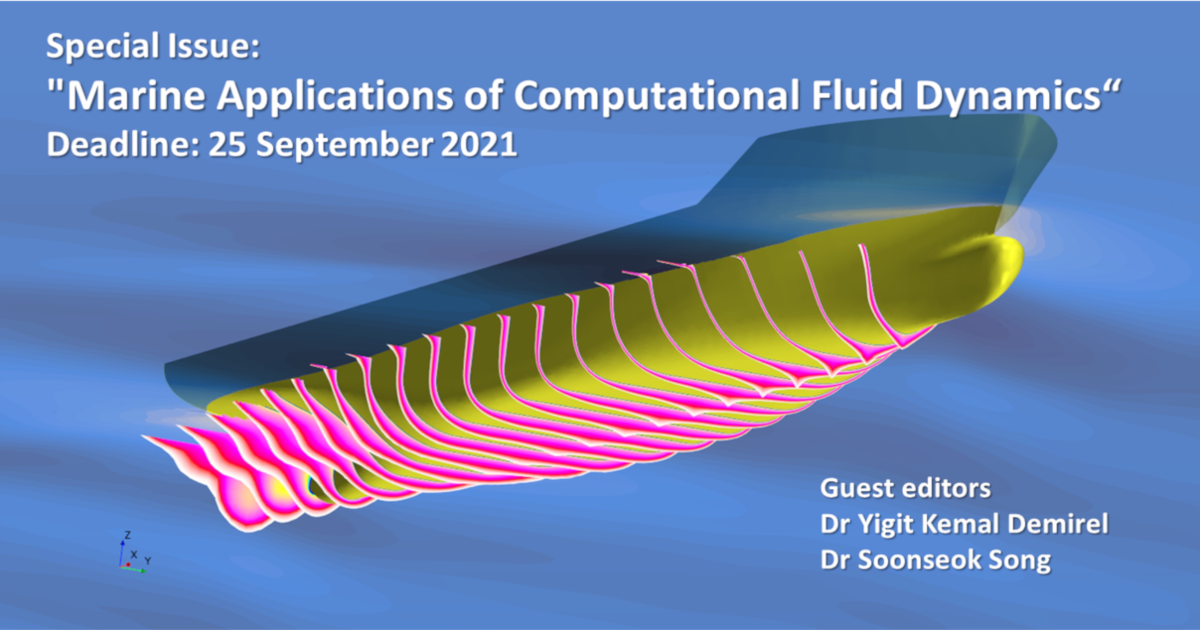Marine Applications of Computational Fluid Dynamics
A special issue of Journal of Marine Science and Engineering (ISSN 2077-1312). This special issue belongs to the section "Ocean Engineering".
Deadline for manuscript submissions: closed (1 March 2022) | Viewed by 29391

Special Issue Editors
Interests: marine hydrodynamics; computational fluid dynamics; ship resistance and propulsion; fouling/coating hydrodynamics; seakeeping; fouling-control coatings; numerical modeling
Special Issues, Collections and Topics in MDPI journals
Interests: ship hydrodynamics; ocean renewable energy; computational fluid dynamics (CFD)
Special Issues, Collections and Topics in MDPI journals
Special Issue Information
Dear Colleagues,
This Special Issue focuses on the Marine Applications of Computational Fluid Dynamics with a specific emphasis on the applications of naval architecture, ocean, and marine engineering. CFD is an emerging area and is gaining popularity due to the availability of ever-increasing computational power. If used accurately, CFD methods may overcome the limitations of experimental and other numerical methods, in some respects.
We invite researchers from both academia and industry to submit original articles that advance state-of-the-art marine applications of computational fluid dynamics or review the progress and future directions of research in this field. The scope of this Special Issue covers the range of subjects relevant to naval architecture, ocean, and marine engineering. The applications will include ships, oil and gas platforms, and marine and offshore renewable energy structures.
Dr. Yigit Kemal Demirel
Dr. Soonseok Song
Guest Editors
Manuscript Submission Information
Manuscripts should be submitted online at www.mdpi.com by registering and logging in to this website. Once you are registered, click here to go to the submission form. Manuscripts can be submitted until the deadline. All submissions that pass pre-check are peer-reviewed. Accepted papers will be published continuously in the journal (as soon as accepted) and will be listed together on the special issue website. Research articles, review articles as well as short communications are invited. For planned papers, a title and short abstract (about 250 words) can be sent to the Editorial Office for assessment.
Submitted manuscripts should not have been published previously, nor be under consideration for publication elsewhere (except conference proceedings papers). All manuscripts are thoroughly refereed through a single-blind peer-review process. A guide for authors and other relevant information for submission of manuscripts is available on the Instructions for Authors page. Journal of Marine Science and Engineering is an international peer-reviewed open access semimonthly journal published by MDPI.
Please visit the Instructions for Authors page before submitting a manuscript. The Article Processing Charge (APC) for publication in this open access journal is 2600 CHF (Swiss Francs). Submitted papers should be well formatted and use good English. Authors may use MDPI's English editing service prior to publication or during author revisions.
Keywords
- ship resistance and propulsion
- seakeeping and maneuverability
- vortex-induced motions (VIMs) and vortex-induced vibrations (VIVs)
- validation and verification of computational fluid dynamics (CFD)
- fluid/structure interaction
- EFD/CFD combined methods
- drag reduction technologies
- fouling/coating hydrodynamics
Benefits of Publishing in a Special Issue
- Ease of navigation: Grouping papers by topic helps scholars navigate broad scope journals more efficiently.
- Greater discoverability: Special Issues support the reach and impact of scientific research. Articles in Special Issues are more discoverable and cited more frequently.
- Expansion of research network: Special Issues facilitate connections among authors, fostering scientific collaborations.
- External promotion: Articles in Special Issues are often promoted through the journal's social media, increasing their visibility.
- Reprint: MDPI Books provides the opportunity to republish successful Special Issues in book format, both online and in print.
Further information on MDPI's Special Issue policies can be found here.






